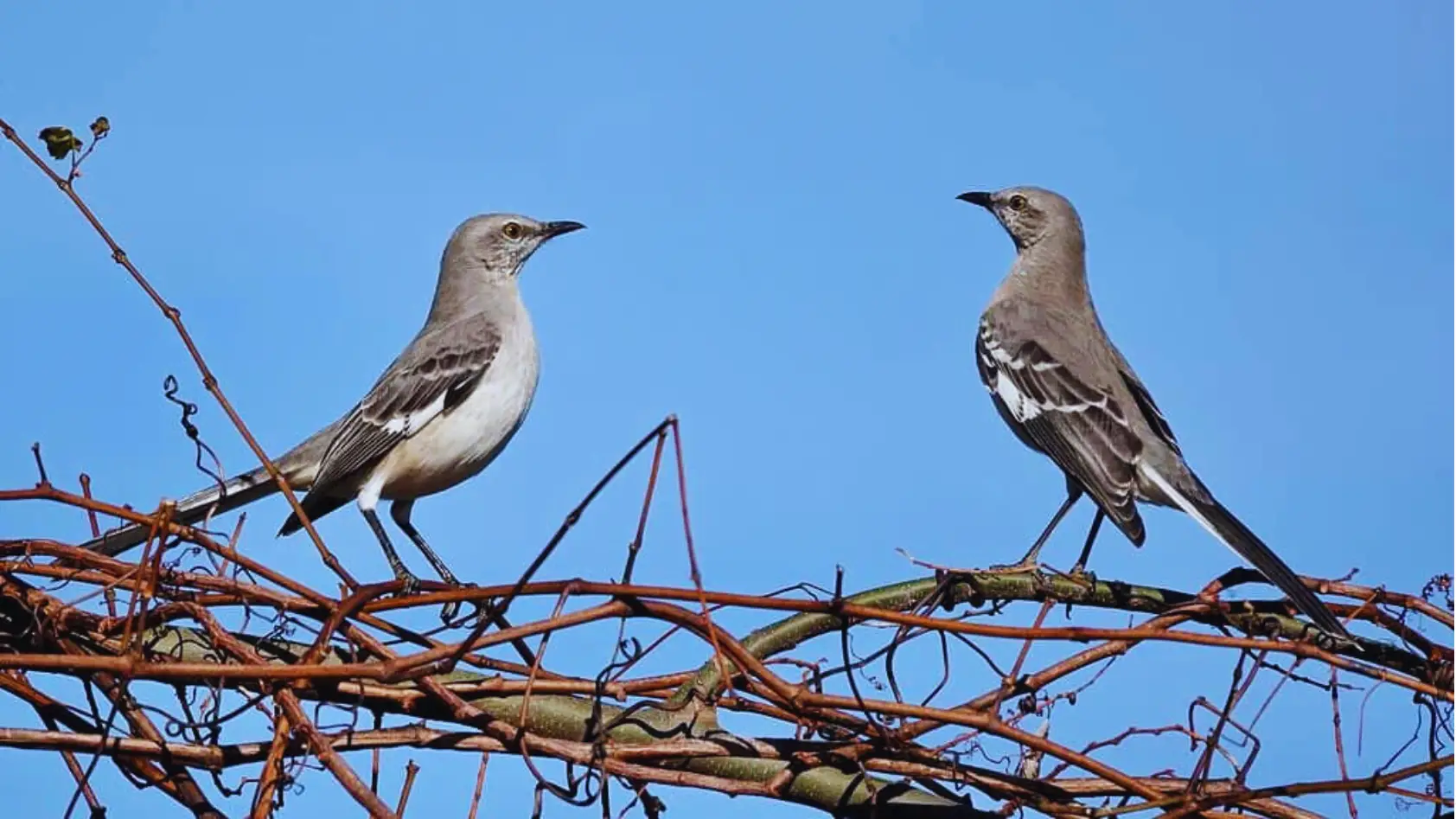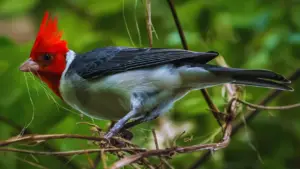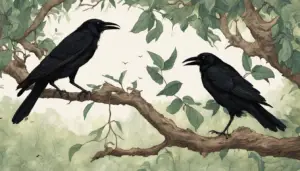Catbird vs Mockingbird: A Tale of Two Chirping Champions
Are you curious about the melodic symphonies that fill the air? Do you ever wonder which bird is behind those enchanting chirps? Look no further than the catbird and the mockingbird, two chirping champions that captivate us with their beautiful songs.
In this article, we will explore the intriguing world of these feathered musicians and discover what sets them apart. From their habitat and physical characteristics to their unique vocalizations and breeding behaviors, we will delve into the lives of these avian virtuosos.
Additionally, we will examine their interactions with other bird species and shed light on their conservation status and threats they face. Finally, we will explore the cultural significance and symbolism of these birds, recognizing their important role in our lives.
So, get ready to embark on a journey of discovery as we unravel the tale of the catbird and the mockingbird, two chirping champions that truly make the world a more melodious place.
Key Takeaways
- Catbirds and mockingbirds are two bird species known for their beautiful songs.
- Catbirds excel in creating their own songs, while mockingbirds shine in mimicry.
- Catbirds have a smaller and more rounded body shape compared to mockingbirds.
- Catbirds have a wide vocal range and can imitate other birds’ calls, while mockingbirds can mimic a wide range of sounds, including car alarms and human voices.
Overview of Catbirds and Mockingbirds
You might be surprised to learn that both catbirds and mockingbirds, despite their similarities in appearance, possess distinct vocal abilities that set them apart from each other.
Catbirds are known for their melodious songs, which are often described as a combination of mewing and whistling. They have a wide vocal range and can produce various notes and trills. Their songs are complex and can last for several minutes.
On the other hand, mockingbirds are master mimics. They have the ability to imitate the songs of other birds and even some non-bird sounds like car alarms or cell phone rings. Mockingbirds can mimic over 200 different sounds, and they often incorporate these imitations into their own unique songs. They are known for their impressive vocal displays, which involve repeating phrases and incorporating different melodies.
While catbirds excel in creating their own songs, mockingbirds shine in their ability to mimic and incorporate a wide variety of sounds into their repertoire.
So, next time you hear a bird chirping away, take a closer look and listen carefully to determine if it’s a catbird or a mockingbird, and you’ll be amazed at their distinct vocal abilities.
Habitat and Geographic Distribution
Nestled among the trees and shrubs of North America, these feathered virtuosos fill the air with an enchanting symphony, captivating both the wild and human ears alike. Catbirds and mockingbirds, with their melodious calls and imitations, are a delight to encounter in their natural habitats.
Both catbirds and mockingbirds are found throughout North America, but they have slightly different geographic distributions. Catbirds prefer dense thickets, wooded areas, and shrubby habitats, while mockingbirds are more adaptable and can be found in a wider range of habitats, including forests, parks, and urban areas. Mockingbirds are commonly found in the southern parts of North America, while catbirds can be found in both the eastern and western parts of the continent.
To further understand the habitat preferences of these avian virtuosos, let’s take a look at the table below:
| Catbirds | Mockingbirds |
|---|---|
| Dense thickets | Forests |
| Wooded areas | Parks |
| Shrubby habitats | Urban areas |
| Eastern and Western North America | Southern North America |
As you can see, catbirds thrive in more secluded and natural environments, while mockingbirds are adaptable and can be found in a variety of settings. No matter where they are found, both species bring joy and a sense of wonder to those who have the pleasure of hearing their beautiful songs.
Physical Characteristics
When it comes to physical characteristics, you’ll notice that catbirds and mockingbirds differ in size and shape.
Catbirds are slightly smaller and have a more rounded body shape, while mockingbirds are larger and have a more slender body shape.
In terms of coloration and markings, catbirds are typically dark gray with a black cap and a rusty undertail, while mockingbirds have a grayish-brown back, a white belly, and white patches on their wings.
Size and Shape
Contrary to popular belief, the size and shape of a bird’s beak greatly impact its ability to produce distinct chirping sounds. When comparing catbirds and mockingbirds, their size and shape play a significant role in their chirping abilities.
Catbirds have a small, slender beak that allows them to produce high-pitched, melodic chirps. Their beaks are well-suited for creating a wide range of sounds, making their songs complex and beautiful.
On the other hand, mockingbirds have a longer, curved beak that enables them to produce louder and more varied chirping sounds. Their beaks act as natural amplifiers, allowing them to mimic the calls of other birds and produce a diverse repertoire of songs.
So, next time you hear a catbird or mockingbird chirping away, remember that their size and shape are key factors in their chirping prowess.
Coloration and Markings
To fully appreciate the significance of coloration and markings in bird species, imagine yourself observing a vibrant red cardinal and a dull brown sparrow, and notice how their distinct hues help them blend into their respective environments. The catbird and mockingbird, though similar in size and shape, exhibit striking differences in their coloration and markings. The catbird boasts a sleek black plumage with a small patch of chestnut under its tail, while the mockingbird flaunts a grayish-brown plumage with white patches on its wings and tail. These distinct color patterns serve a purpose beyond aesthetics. The catbird’s dark plumage helps it camouflage among the shadows of dense vegetation, while the mockingbird’s grayish-brown plumage allows it to blend in with the leaves and branches of trees. Thus, coloration and markings play a crucial role in the survival and adaptation of these avian species.
| Bird Species | Coloration | Markings |
|---|---|---|
| Catbird | Black | Chestnut |
| Mockingbird | Grayish-brown | White patches |
Vocalizations
Despite their similar appearances, catbirds and mockingbirds have distinct vocalizations that showcase their unique personalities and individuality.
When it comes to vocalizations, catbirds are known for their impressive range of sounds. They have a melodic and musical quality to their songs, often incorporating a mix of whistles, trills, and mews. Catbirds are skilled mimics and can imitate the calls of other birds, adding a touch of variety to their repertoire. Their songs are often complex and can last for several minutes, with each song being unique to the individual bird.
On the other hand, mockingbirds are famous for their ability to mimic a wide range of sounds, not just other birds, but also car alarms, sirens, and even human voices. They are master imitators and can flawlessly replicate the songs of other birds, often incorporating them into their own songs. Mockingbirds have a diverse and ever-changing repertoire, with each bird having its own signature style. They are known for their energetic and enthusiastic singing, often singing throughout the day and even into the night.
In conclusion, while both catbirds and mockingbirds have distinct vocalizations, catbirds are known for their melodic and musical songs, while mockingbirds are celebrated for their impressive mimicry and diverse repertoire. Their vocalizations add depth and charm to their already captivating personalities, making them true chirping champions in their own unique ways.
Breeding and Nesting Behavior
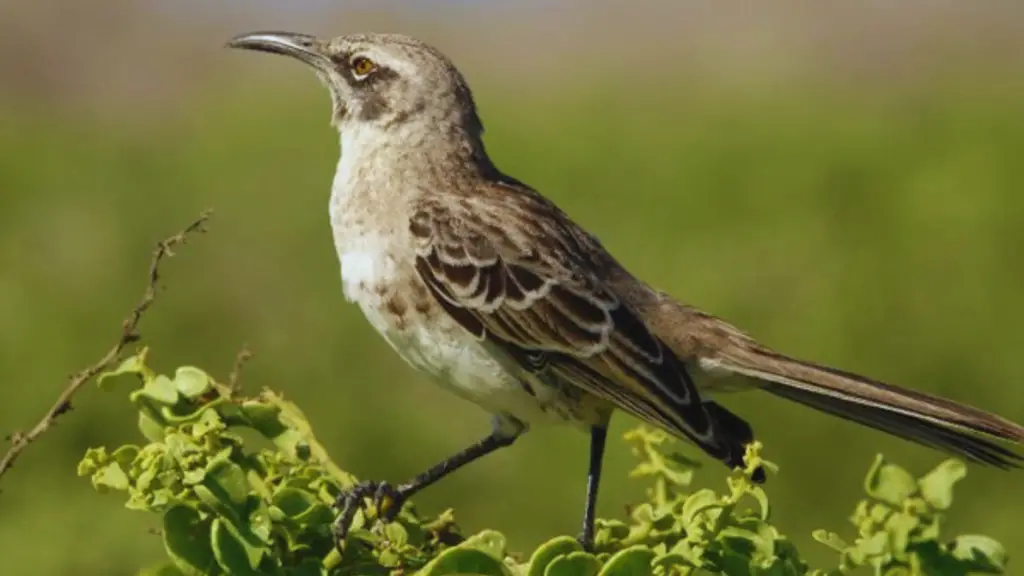
Breeding and nesting behavior in catbirds and mockingbirds can provide fascinating insights into their unique parenting strategies and dedication to their offspring. For example, a study conducted in a suburban neighborhood found that catbirds built their nests in dense shrubs near human dwellings, showcasing their adaptability and ability to utilize human-altered landscapes for successful breeding.
The sight of a catbird fiercely defending its nest against predators evokes a sense of awe and admiration for its protective instincts.
Witnessing the delicate construction of a mockingbird’s nest, intricately woven with twigs and grass, elicits a feeling of wonder at their architectural skills.
Observing the synchronized feeding efforts of catbird parents, taking turns to gather food for their hungry chicks, evokes a sense of teamwork and cooperation.
The melodious songs of both catbirds and mockingbirds during the breeding season stir emotions of joy and tranquility, creating an enchanting ambiance in their surroundings.
As dedicated parents, catbirds and mockingbirds invest significant time and energy into raising their young. Their breeding and nesting behaviors highlight their adaptability, resourcefulness, and commitment to ensuring the survival of their offspring.
These avian champions of parenting provide a captivating glimpse into the wonders of nature and the remarkable strategies employed by different species to thrive in their environments.
Diet and Feeding Habits
Indulge your senses as you discover the diverse and fascinating diet and feeding habits of these remarkable songbirds.
Both the catbird and the mockingbird are known for their ability to mimic the sounds of other birds and even human noises, but their culinary preferences differ.
The catbird is primarily an insectivore, feeding on a wide variety of insects such as beetles, ants, and caterpillars. They also enjoy feasting on fruits, berries, and seeds, making them an important disperser of plants.
In contrast, the mockingbird is an omnivore, meaning it eats both animals and plants. They have a varied diet that includes insects, spiders, small reptiles, fruits, berries, and even seeds. Their ability to adapt to different food sources allows them to survive in a wide range of habitats.
Both birds are excellent foragers, using their sharp eyesight and agile movements to catch prey. Whether it’s the catbird stealthily hunting insects or the mockingbird swooping down on a juicy berry, these chirping champions are sure to captivate you with their amazing diet and feeding habits.
Migration Patterns and Seasonal Movements
Get ready to be amazed by the migratory patterns and seasonal movements of these incredible songbirds. Both the catbird and the mockingbird exhibit fascinating behaviors when it comes to migration.
While the catbird is known for its short-distance migration, usually traveling only a few hundred miles, the mockingbird is a long-distance traveler. Mockingbirds can cover thousands of miles during their migration, flying from their breeding grounds in the northern regions to warmer climates in the south.
The table below highlights some key differences in the migration patterns and seasonal movements of these two chirping champions:
| Catbird | Mockingbird |
|---|---|
| Short-distance migration | Long-distance migration |
| Moves to nearby areas | Flies thousands of miles |
| Breeds in the northern regions | Breeds in various regions |
| Seeks warmer climates during winter | Migrates to southern regions |
As you can see, the catbird has a more localized movement, moving to nearby areas and seeking warmer climates during the winter. On the other hand, the mockingbird undertakes a remarkable journey, covering vast distances and breeding in different regions.
These migration patterns and seasonal movements not only showcase the adaptability of these songbirds but also emphasize the importance of preserving their habitats across different regions to ensure their survival.
Interactions with Other Bird Species
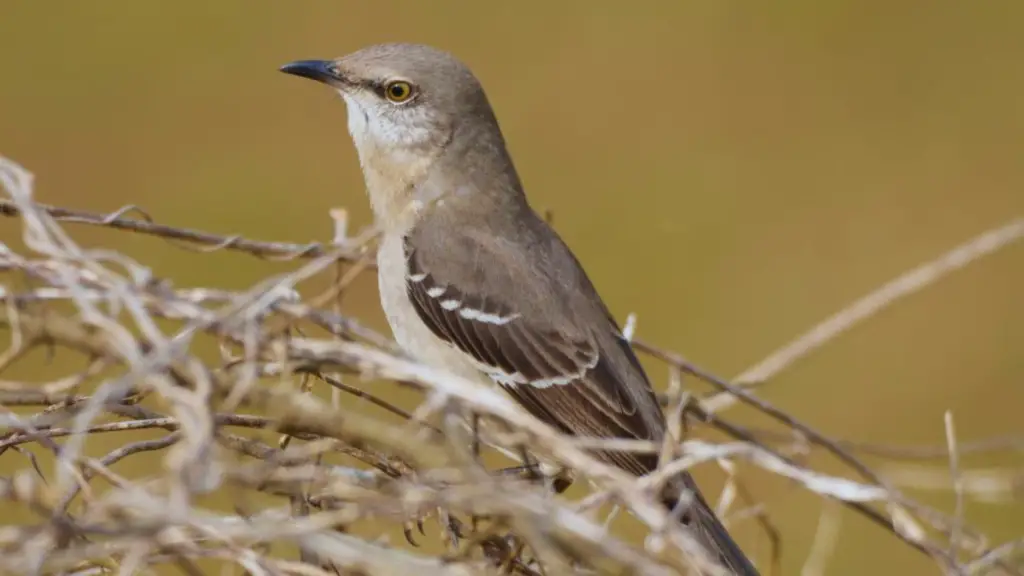
When it comes to interactions with other bird species, you’ll find that territorial behavior and competition for resources are key points to consider.
Birds can be quite territorial, defending their nesting sites and foraging areas from other species. This territorial behavior often leads to competition for resources such as food, water, and nesting materials.
Territorial Behavior
Imagine yourself in the middle of a fierce competition between a catbird and a mockingbird. Their territorial behavior becomes a battleground for dominance. These two chirping champions take their territories seriously and will do whatever it takes to defend their space.
Here are four key territorial behaviors that differentiate the catbird from the mockingbird:
- Singing: Both birds are known for their melodious songs. However, the catbird’s repertoire is more diverse, while the mockingbird’s song is more complex and mimicking.
- Nest guarding: The catbird fiercely guards its nest, often attacking intruders with loud calls and aggressive displays. On the other hand, the mockingbird uses its impressive aerial maneuvers to deter predators.
- Territory size: Catbirds have smaller territories compared to mockingbirds. This allows them to focus their energy on defending a smaller area more intensely.
- Physical confrontation: Mockingbirds are more likely to engage in physical confrontations with intruders. They use their sharp beaks and wings to intimidate and fight off threats. Catbirds, on the other hand, tend to rely more on their vocalizations and displays.
As you witness this territorial battle, you can’t help but admire the determination and resourcefulness of these avian competitors.
Competition for Resources
Witnessing the fierce competition between these territorial birds highlights the intense rivalry for limited resources. When it comes to food, catbirds and mockingbirds will stop at nothing to secure their next meal.
Picture this: you’re sitting in your backyard, enjoying a sunny afternoon, when suddenly you hear a chorus of chirping. You look up and see two birds, a catbird and a mockingbird, engaged in a heated battle over a juicy worm. They dart back and forth, trying to outmaneuver each other, their sharp beaks snapping in the air.
It’s a high-stakes game, and only the quickest and most cunning bird will emerge victorious. In this battle for survival, every twig, berry, and insect becomes a precious commodity.
So next time you see these chirping champions in action, remember the fierce competition they face for the scarce resources that sustain them.
Conservation Status and Threats
Although both the catbird and mockingbird are chirping champions, they face different conservation statuses and threats. The catbird, also known as the gray catbird, is classified as a species of least concern by the International Union for Conservation of Nature (IUCN). This means that it is not currently at risk of extinction. However, the catbird population is still susceptible to threats such as habitat loss and degradation due to urbanization and agriculture. Climate change is also a concern, as it can alter the catbird’s habitat and affect its food sources.
On the other hand, the mockingbird, specifically the northern mockingbird, is also classified as a species of least concern by the IUCN. However, there are some populations of the species that are facing declines, particularly in certain regions. The main threats to mockingbirds include habitat loss, predation by invasive species, and exposure to pesticides.
To engage the audience, here are three interesting facts about the conservation status and threats faced by catbirds and mockingbirds:
- The catbird and mockingbird are both adaptable species, but they still face challenges in maintaining their populations.
- Conservation efforts such as habitat protection and restoration can help mitigate the threats faced by both species.
- Monitoring and research are crucial for understanding the population dynamics and threats faced by catbirds and mockingbirds, allowing for targeted conservation actions.
Cultural Significance and Symbolism
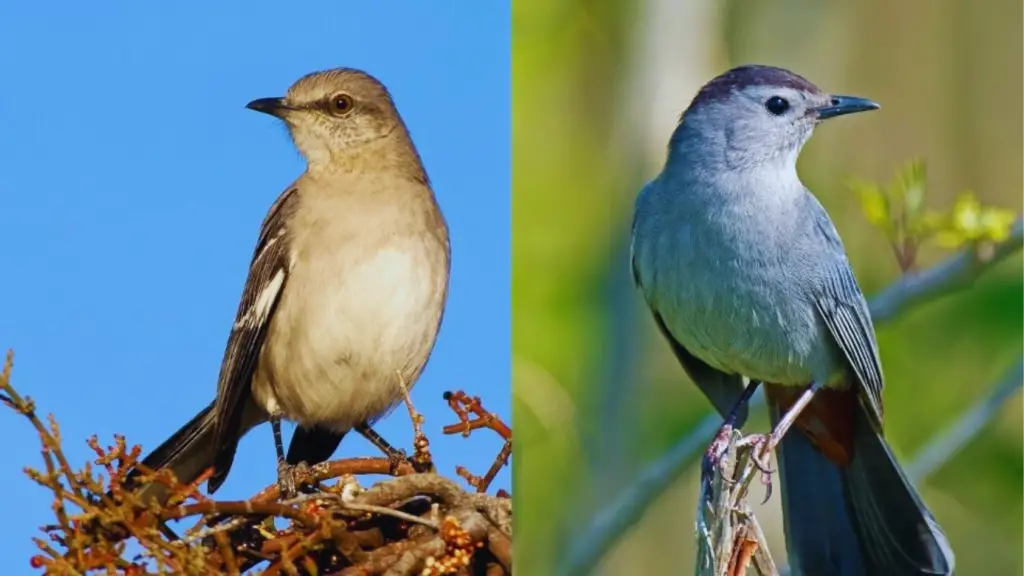
You’ll be amazed by the cultural significance and symbolism surrounding these remarkable birds. Both catbirds and mockingbirds have captured the imagination of people throughout history.
In many cultures, these birds are seen as symbols of communication and creativity.
For Native American tribes, the catbird is considered a messenger from the spirit world. Its beautiful singing is believed to carry important messages and guidance from the ancestors. The catbird’s ability to mimic other bird songs is seen as a sign of adaptability and intelligence.
Similarly, the mockingbird holds a special place in many cultures. In literature and folklore, mockingbirds are often portrayed as wise and cunning creatures. Their ability to imitate the songs of other birds is seen as a reflection of their ability to adapt to different situations and environments.
In addition to their symbolic significance, both catbirds and mockingbirds have also inspired artists and musicians. Their melodic songs have been featured in countless songs, poems, and paintings. Their unique ability to mimic sounds has captivated artists and musicians, who see it as a representation of the power of creativity and expression.
In conclusion, the cultural significance and symbolism surrounding catbirds and mockingbirds is truly remarkable. From their role as messengers in Native American folklore to their influence on art and music, these birds continue to captivate and inspire people around the world.
Conclusion: Appreciating the Chirping Champions
Take a moment to appreciate the incredible beauty and significance of these magnificent birds. Both the catbird and the mockingbird are true chirping champions, bringing joy and melody to our lives. While they may have their differences, they both deserve our admiration.
The catbird, with its sleek gray feathers and distinctive black cap, is known for its melodious and varied songs. Its ability to mimic the sounds of other birds and even human voices is truly remarkable. It adds a touch of magic to our gardens and parks.
On the other hand, the mockingbird, with its gray plumage and long tail, is a master of improvisation. Its repertoire includes a medley of songs and calls, each one delivered with precision and enthusiasm. It fills the air with its vibrant melodies, bringing life to even the dullest of surroundings.
To better appreciate the unique qualities of these chirping champions, let’s compare them side by side:
| Catbird | Mockingbird |
|---|---|
| Mimics sounds of other birds and humans | Master of improvisation |
| Melodious and varied songs | Vibrant and diverse repertoire |
| Sleek gray feathers with black cap | Gray plumage with long tail |
In conclusion, whether you prefer the catbird’s mimicry or the mockingbird’s improvisation, both birds deserve our admiration and appreciation. Their songs bring beauty and joy to our world, reminding us of the wonders of nature. So next time you hear their chirping, take a moment to pause and listen, for these birds are true champions of melody.
FAQs About Catbird Vs Mockingbird
How do catbirds and mockingbirds defend their territories from other bird species?
To defend their territories from other bird species, catbirds and mockingbirds employ a combination of fierce chirping and symbolic displays. They use their voices like swords, piercing the air to establish dominance and ward off intruders.
What is the average lifespan of a catbird or mockingbird?
The average lifespan of a catbird or mockingbird is around 8-10 years. They have shorter lifespans compared to some other bird species, but they make up for it with their energetic and lively presence.
Do catbirds and mockingbirds have any natural predators?
Yes, catbirds and mockingbirds have natural predators. They both face threats from predators such as snakes, cats, and birds of prey. These predators pose a constant danger to their survival.
Can catbirds and mockingbirds mimic sounds other than bird songs?
Yes, both catbirds and mockingbirds can mimic sounds other than bird songs. They are known to imitate sounds such as car alarms, sirens, and even human voices.
How do catbirds and mockingbirds communicate with each other within their species?
Catbirds and mockingbirds communicate within their species through a variety of vocalizations, including calls, songs, and even physical displays. For example, catbirds use a harsh “mew” call to signal aggression or territoriality to other catbirds.
Conclusion
So there you have it, fellow bird enthusiasts! After exploring the world of catbirds and mockingbirds, it’s clear that these chirping champions are truly remarkable.
From their diverse habitats and remarkable vocalizations to their impressive breeding behaviors and interactions with other bird species, these feathered friends never cease to amaze.
As you venture into nature, keep your ears open for their melodic tunes, and let the symphony of their calls transport you to a world of wonder.
So go forth, embrace the beauty of these avian wonders, and let their songs fill your heart with joy.

